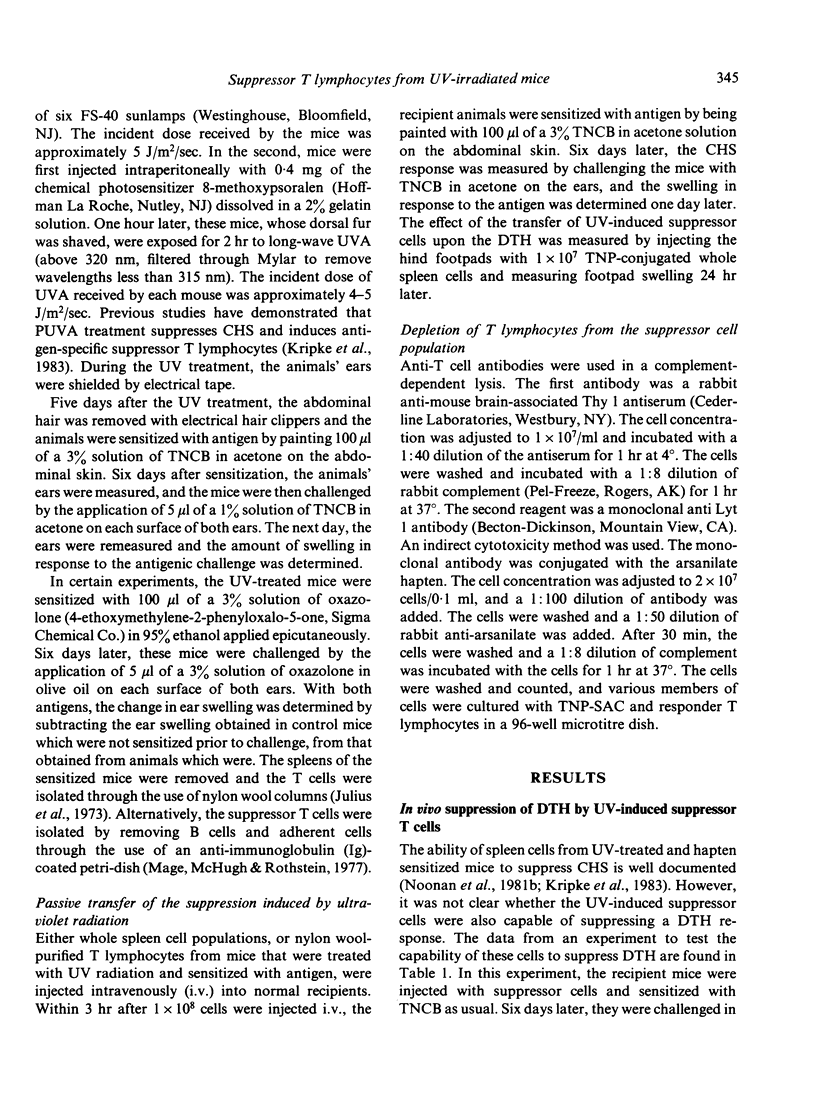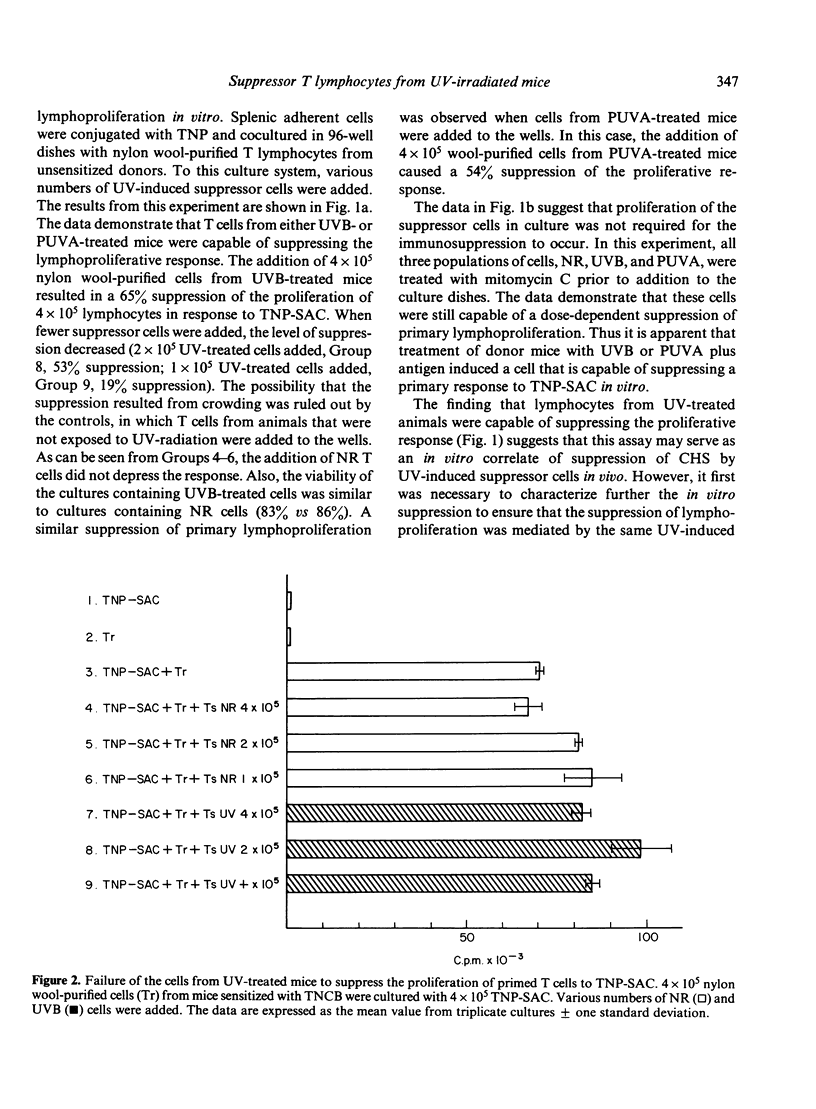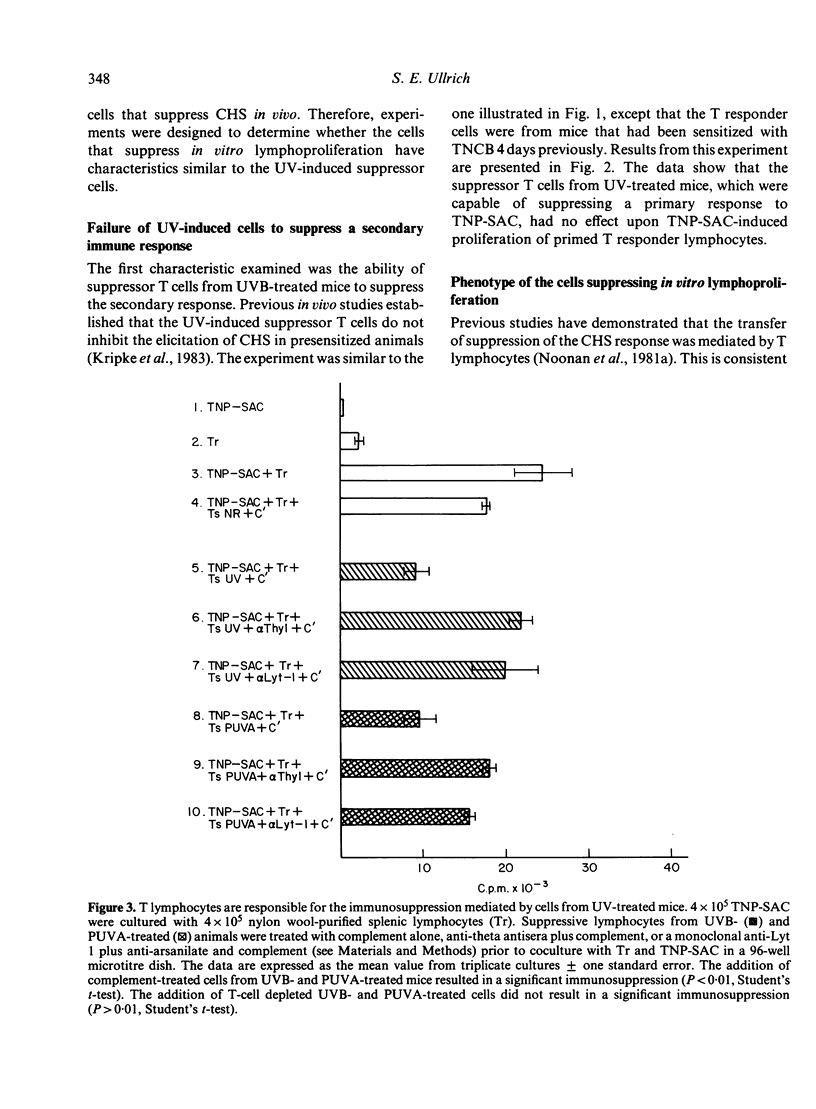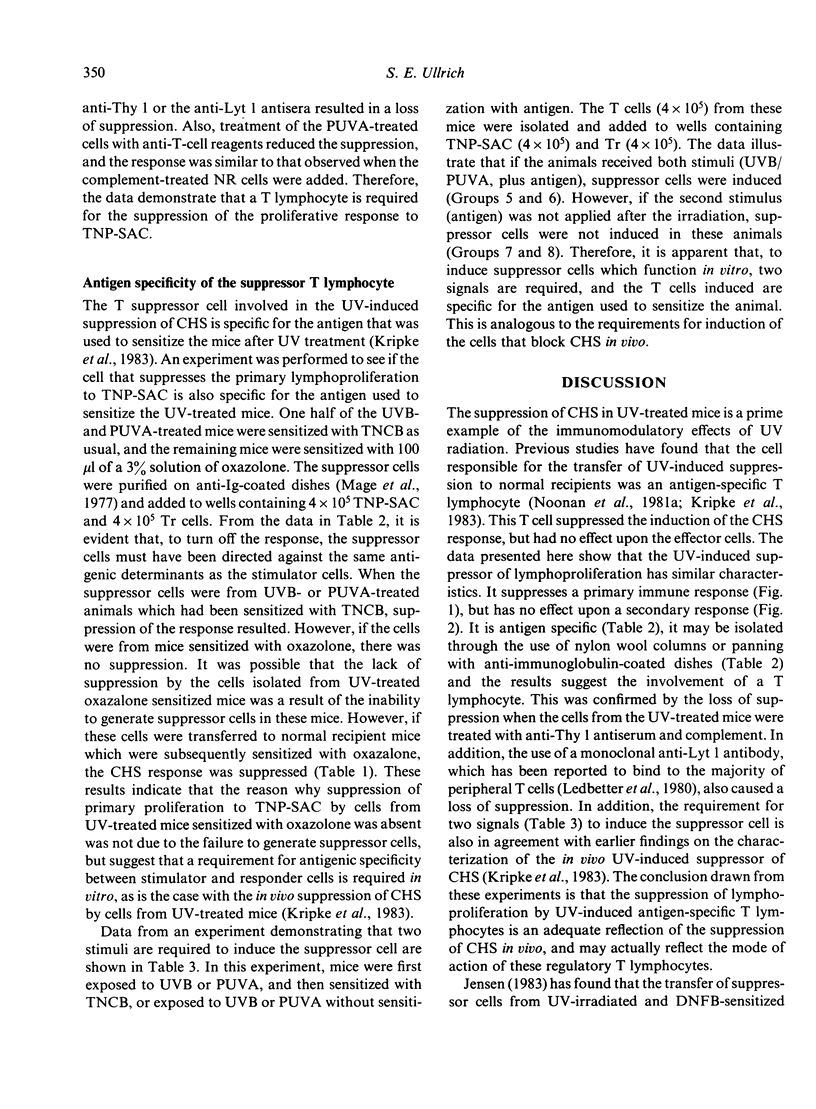Abstract
Application of a contact-sensitizing agent to the skin of mice previously exposed to UV radiation at a different site results in the induction of hapten-specific suppressor T lymphocytes. When splenic lymphocytes from such mice were cultured with normal lymphocytes and hapten-conjugated splenic adherent cells, the primary proliferative response was suppressed. The cell responsible for the suppression in vitro was a T lymphocyte, and two signals were required for its induction, ultraviolet radiation and hapten sensitization. The T cell suppressing lymphoproliferation was specific for the hapten applied after UV radiation. The UV-induced T suppressor cell inhibited only primary lymphoproliferation; the response of lymphocytes from immunized mice was unaffected. The activity of the UV-induced suppressor cell was not affected by mitomycin C treatment. Thus, suppression of the primary proliferative response of lymphocytes to hapten-modified syngeneic cells in vitro correlates with in vivo suppression of contact hypersensitivity by these UV-induced suppressor cells. This suggests that the suppressor cells act by preventing the proliferation of hapten-specific responder clones. Use of this in vitro assay system should facilitate investigation of the characteristics of these cells and the mechanism by which these regulatory T lymphocytes inhibit contact sensitization.
Full text
PDF









Selected References
These references are in PubMed. This may not be the complete list of references from this article.
- Eardley D. D., Hugenberger J., McVay-Boudreau L., Shen F. W., Gershon R. K., Cantor H. Immunoregulatory circuits among T-cell sets. I. T-helper cells induce other T-cell sets to exert feedback inhibition. J Exp Med. 1978 Apr 1;147(4):1106–1115. doi: 10.1084/jem.147.4.1106. [DOI] [PMC free article] [PubMed] [Google Scholar]
- Gershon R. K., Kondo K. Cell interactions in the induction of tolerance: the role of thymic lymphocytes. Immunology. 1970 May;18(5):723–737. [PMC free article] [PubMed] [Google Scholar]
- Glimcher L. H., Longo D. L., Green I., Schwartz R. H. Murine syngeneic mixed lymphocyte response. I. Target antigens are self Ia molecules. J Exp Med. 1981 Nov 1;154(5):1652–1670. doi: 10.1084/jem.154.5.1652. [DOI] [PMC free article] [PubMed] [Google Scholar]
- Jensen P. J. The involvement of antigen-presenting cells and suppressor cells in the ultraviolet radiation-induced inhibition of secondary cytotoxic T cell sensitization. J Immunol. 1983 May;130(5):2071–2074. [PubMed] [Google Scholar]
- Jerne N. K. Towards a network theory of the immune system. Ann Immunol (Paris) 1974 Jan;125C(1-2):373–389. [PubMed] [Google Scholar]
- Jessup J. M., Hanna N., Palaszynski E., Kripke M. L. Mechanisms of depressed reactivity to dinitrochlorobenzene and ultraviolet-induced tumors during ultraviolet carcinogenesis in BALB/c mice. Cell Immunol. 1978 Jun;38(1):105–115. doi: 10.1016/0008-8749(78)90036-9. [DOI] [PubMed] [Google Scholar]
- Julius M. H., Simpson E., Herzenberg L. A. A rapid method for the isolation of functional thymus-derived murine lymphocytes. Eur J Immunol. 1973 Oct;3(10):645–649. doi: 10.1002/eji.1830031011. [DOI] [PubMed] [Google Scholar]
- Kripke M. L. Immunologic mechanisms in UV radiation carcinogenesis. Adv Cancer Res. 1981;34:69–106. doi: 10.1016/s0065-230x(08)60239-0. [DOI] [PubMed] [Google Scholar]
- Kripke M. L., Morison W. L., Parrish J. A. Systemic suppression of contact hypersensitivity in mice by psoralen plus UVA radiation (PUVA). J Invest Dermatol. 1983 Aug;81(2):87–92. doi: 10.1111/1523-1747.ep12542071. [DOI] [PubMed] [Google Scholar]
- Ledbetter J. A., Rouse R. V., Micklem H. S., Herzenberg L. A. T cell subsets defined by expression of Lyt-1,2,3 and Thy-1 antigens. Two-parameter immunofluorescence and cytotoxicity analysis with monoclonal antibodies modifies current views. J Exp Med. 1980 Aug 1;152(2):280–295. doi: 10.1084/jem.152.2.280. [DOI] [PMC free article] [PubMed] [Google Scholar]
- Mage M. G., McHugh L. L., Rothstein T. L. Mouse lymphocytes with and without surface immunoglobulin: preparative scale separation in polystyrene tissue culture dishes coated with specifically purified anti-immunoglobulin. J Immunol Methods. 1977;15(1):47–56. doi: 10.1016/0022-1759(77)90016-3. [DOI] [PubMed] [Google Scholar]
- Moorhead J. W. Tolerance and contact sensitivity to DNFB in mice. VI. Inhibition of afferent sensitivity by suppressor T cells in adoptive tolerance. J Immunol. 1976 Sep;117(3):802–806. [PubMed] [Google Scholar]
- Noonan F. P., De Fabo E. C., Kripke M. L. Suppression of contact hypersensitivity by UV radiation and its relationship to UV-induced suppression of tumor immunity. Photochem Photobiol. 1981 Dec;34(6):683–689. [PubMed] [Google Scholar]
- Noonan F. P., Kripke M. L., Pedersen G. M., Greene M. I. Suppression of contact hypersensitivity in mice by ultraviolet irradiation is associated with defective antigen presentation. Immunology. 1981 Jul;43(3):527–533. [PMC free article] [PubMed] [Google Scholar]
- Rich S. S., Rich R. R. Regulatory mechanisms in cell-mediated immune responses. I. Regulation of mixed lymphocyte reactions by alloantigen-activated thymus-derived lymphocytes. J Exp Med. 1974 Dec 1;140(6):1588–1603. doi: 10.1084/jem.140.6.1588. [DOI] [PMC free article] [PubMed] [Google Scholar]
- Shearer G. M., Lozner E. C., Rehn T. G., Schmitt-Verhulst A. M. Mixed lymphocyte reactivity and cell-mediated lympholysis to trinitrophenyl-modified autologous lymphocytes in C57BL/10 congenic and B10-A recombinant mouse strains. J Exp Med. 1975 Apr 1;141(4):930–934. [PMC free article] [PubMed] [Google Scholar]
- Sy M. S., Miller S. D., Claman H. N. Immune suppression with supraoptimal doses of antigen in contact sensitivity. I. Demonstration of suppressor cells and their sensitivity to cyclophosphamide. J Immunol. 1977 Jul;119(1):240–244. [PubMed] [Google Scholar]
- Thomas W. R., Watkins M. C., Asherson G. L. Suppressor cells for the afferent phase of contact sensitivity to picryl chloride: inhibition of DNA synthesis induced by T cells from mice injected with picryl sulfonic acid. J Immunol. 1979 Jun;122(6):2300–2303. [PubMed] [Google Scholar]
- Waltenbaugh C., Thèze J., Kapp J. A., Benacerraf B. Immunosuppressive factor(s) specific for L-glutamic acid50-L-tyrosine50 (GT). III. Generation of suppressor T cells by a suppressive extract derived from GT-primed lymphoid cells. J Exp Med. 1977 Oct 1;146(4):970–985. doi: 10.1084/jem.146.4.970. [DOI] [PMC free article] [PubMed] [Google Scholar]


